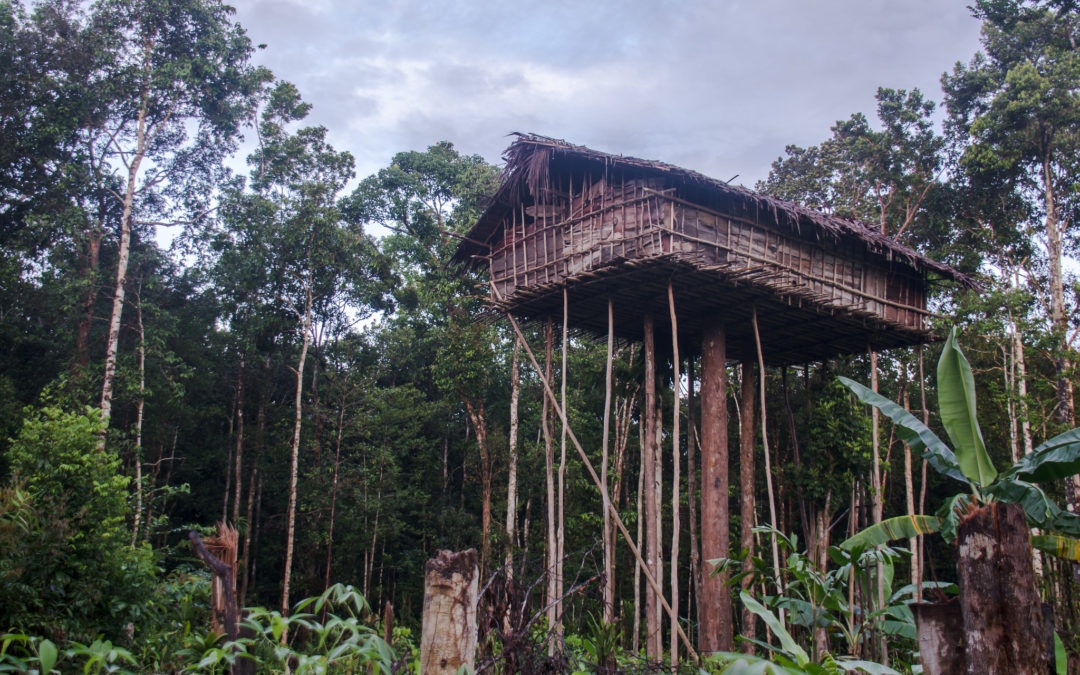About the Korowai
May 2016: Papua is one of the last places on Earth where real, raw and untamed adventure can still be found. It is a land of remote tribes that still live very traditional lives in desolate rainforests, and rugged mountain ranges. This is what first attracted me to Papua in 2009 when I trekked for 2 weeks across the highlands to visit various tribes like the Dali, Lani and Yali. I enjoyed the adventure so much, despite its many hardships, that I decided to Papua this time to visit the lowland rainforests of the Korowai People.
The Korowai are a tribe of people living in the lowland rainforests of southern Indonesian, Papua. They are renowned for their treehouses, some built hundreds of feet above the forest floor. The Korowai are known by anthropologists as being one of the most recent tribes to practice cannibalism. Although it is no longer practiced now, some Korowai are old enough to remember practicing it in their youth.
Due to the area’s extreme geographical isolation of thickly forested swamps, the Korowai only started to come into contact with the outside world in the 1970’s, originally with missionaries, Dutch and Indonesian government and now adventure travelers. Although changes have occurred in the culture of the Korowai, their region is still steeped in superstitions, and they still maintain many of their traditions.
How to Reach the Korowai
My journey to visit the Korowai was a long and arduous one. I first needed to travel to Indonesian Papua. This involved flying via Bali to Jayapura, the provincial capital of Papua. Papua is culturally distinctive from other Indonesian islands. The indigenous people of Papua are Melanesian.
From Jayapura, I flew Trigana Airlines, an airline with a dubious safety record, over the highlands and into the lowland rainforests of Dekai in south Papua. Be sure to book the Trigana flights in advance. When I flew to Jayapura the Trigana flight was full, and I had to wait an extra day in Jayapura waiting for an open flight.
Once in Dekai, I had to visit the local police administration office to obtain a permit, Surat Julan to travel in the region. From Dekai it is an hour drive to the Brazza River, where a long boat must be hired for approx. 1000USD round trip for the 8–10-hour Journey to the government village of Mabul in the Korowai region, a convenient Korowai village to use as a base for trekking into the jungle and visiting Korowai camps.
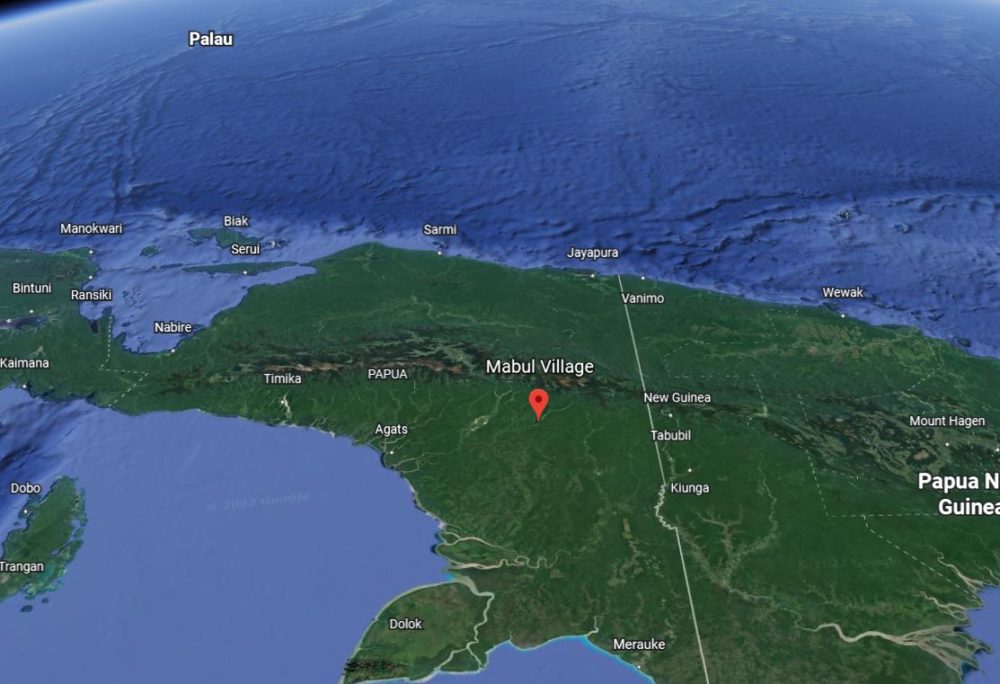
Location of Mabul village
How I Arranged the Trip
All of the operators that provided Korowai trips were crazy expensive, so I decided that I would try and visit the Korowai independently. I knew my biggest challenge would be my inability to speak the Bahasa language. Aside from tribal languages, I knew most people would be able to speak the national language of Indonesia, Bahasa. To resolve this issue, I needed to either find a local guide or a fellow traveler who spoke Bahasa. I tried reaching out to locals in Papua via Facebook, but this turned into a disaster as those I contacted, I quickly realized weren’t reliable and some started calling me relentlessly at all hours of the night to have pointless chats. I turned to other travel forums and via a few online adventure travel friends I was put in contact with Yaz, an adventurous Indonesian girl in her 20’s who was interested in visiting the Korowai. The only catch with her was that she couldn’t afford to travel to the Korowai from her home in Jakarta. I realized that helping her pay for her trip would allow me to have a translator and might be the difference between even being able to reach the Korowai, so I agreed to pay for her expenses once in Papua. Despite that I was helping her with her expenses, she was very clear that she was not my guide and that we were co-travelers.
Going independently to such a wild and remote area also would have its challenges even with the ability to communicate in Bahasa. I had read about independent travelers being robbed at bow and arrow point in the jungle by Korowai bandits. There were a few reports of inter-clan fighting between Korowai over accusations of witchcraft and sometimes the fighting could turn deadly. Then there was also the need to avoid offending the Korowai over any cultural mis0understandings. I heard a report of one foreign man who stayed with a family in a tree house who somehow offended the Korowai, and he ended up “accidentally” falling from the treehouse to his death in the middle of the night. I knew that although adventure travelers were nothing new to the Korowai, it was not common and tourism in the region is still in its early stages and travelers needed to be very culturally sensitive to avoid any mishaps especially when you are in the middle of the jungle staying with a family hour away by boat from the nearest village with a car. Despite these challenges, this is what attracted to me to the Korowai and the lowland rainforests of Papua in the first place and so I went.
The Journey
Prior to arriving in Papua, I was tracking proboscis monkeys in Brunei and king cobras in Bali. From Bali, I flew direct to Jayapura on Lion Air via an overnight flight arriving early in the morning. I met the Indonesia girl in Jayapura and since all the flights to Dekai on Trigana were booked for the day, we booked a flight the following day. Then we spend the day buying provisions for the trip like food, alcohol and balloons, toys for kids, candles, etc. We spent the night with a friend of Yaz. Yaz’s friend had boat contacts in Dekai who had a boat that we could hire to travel to the Korowai. We contacted them and made arrangements to hire the boat.
The next day we departed across the mountains and over the vast rainforests of southern Papua enroute to Dekai. Views from the plane showed unbroken green forest for as far as I could see. sadly, I know that the forest of Papua New Guinea, one of the largest forests left on eart is under threat from all of the usual suspects, logging, mining, settlers expanding into new areas, etc.
Once in Dekai we obtained our permits, which took 30 minutes with a passport copy and photo. No fee required. We met with the owner of the boat and negotiated a price of 18.5 million rupia roundtrip (50% down payment). This price included a boat captain/guide who didn’t speak English except for a few words, car ride from Dekai to Lopon (one hour), one night in Lopon in a boatman’s house, two nights in Mabul (one before the trek and one after), and a roundtrip boat ride (8 hours each way). I arranged for the boat to wait for us in Mabul while we trekked. The captain and his assistants had never been into the jungle before to stay with the Korowai and they asked if they could go with us into the jungle. I decided, this was fine with me because I figured this meant more helpers to ensure a smooth journey and would guarantee that they would depart early with the boat leaving me stranded in Mabul.
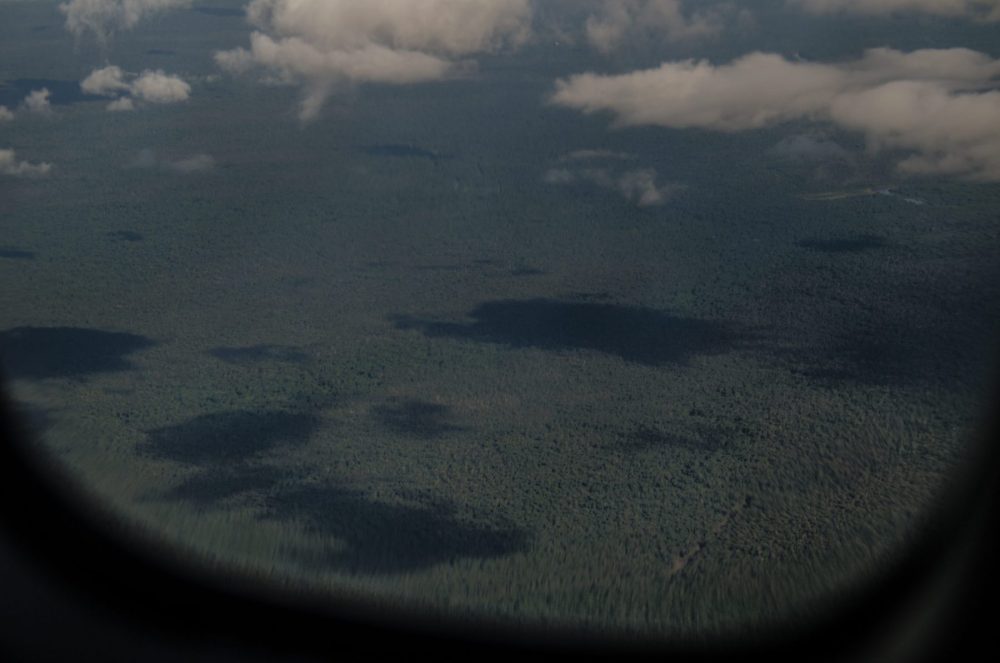
Flight over endless rainforest
Long River Trip
The next morning, we set off in the motorized longboat before sunrise. The river was dark, murky, wild and thickly forested. We passed the occasional fishing settlements but there were no major towns along the way. The river is known for its large crocodiles, but I did not observe any. Our boat had no canopy, so we sat in the open beneath the beaming and powerful rays of the punishing equatorial sun. I wore a floppy hat to keep as much sun off of me as possible and gobs of sun block. Luckily clouds kept the sun somewhat at bay.
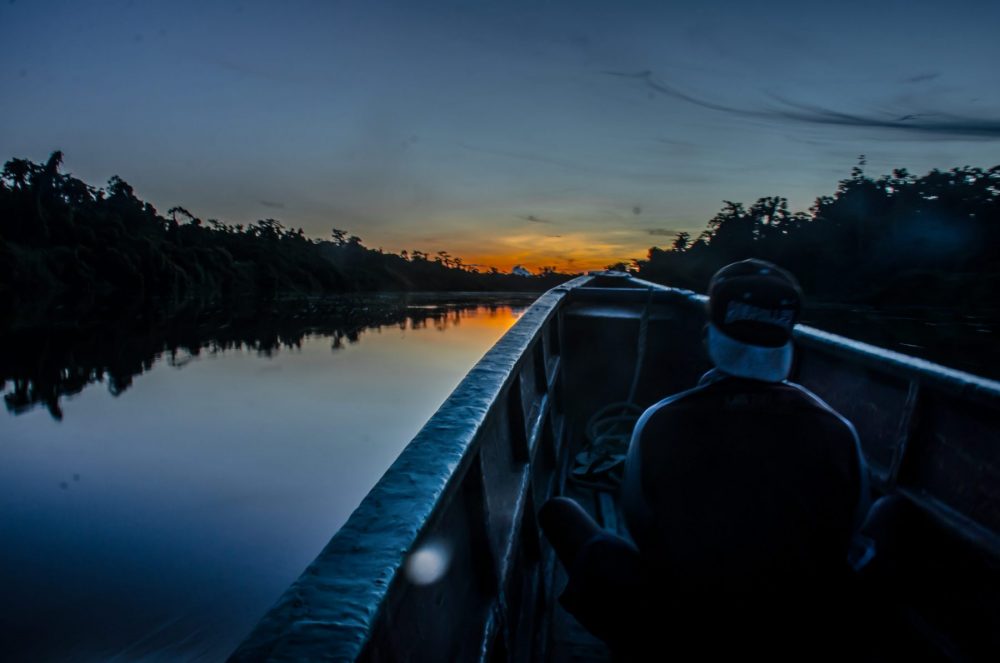
Traveling by boat down the Brazza River to Korowai Territory
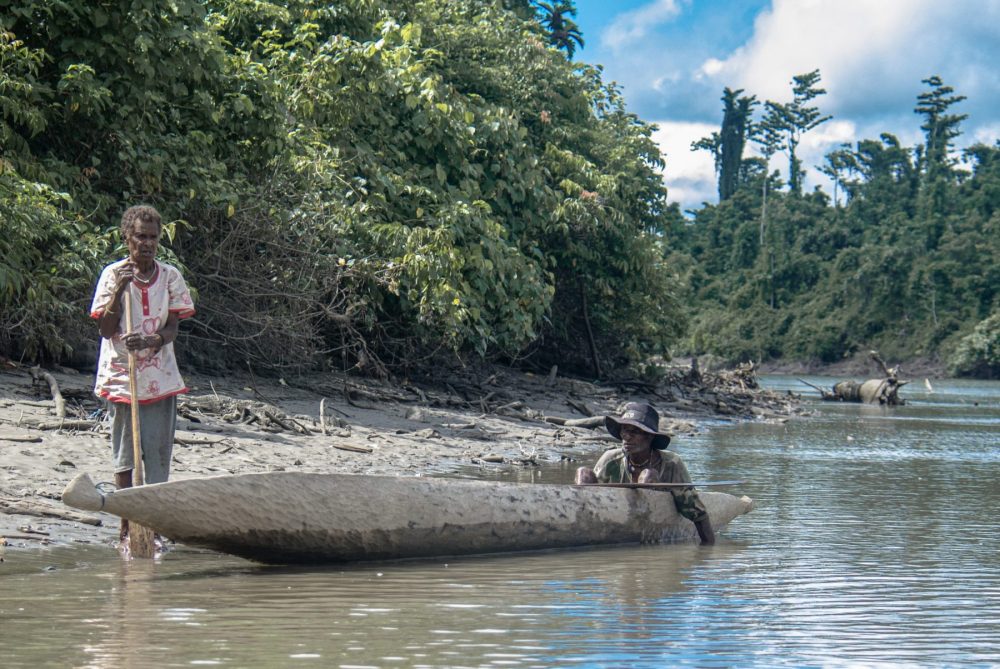
elderly couple fishing
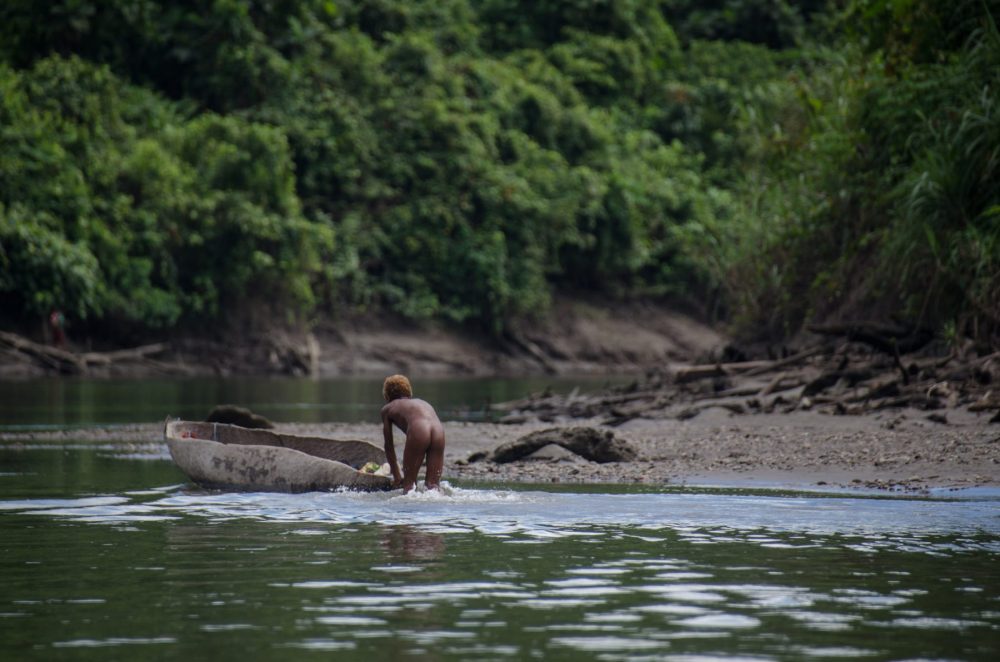
Boy washing himself on the river
Government Korowai Village of Mabul
We arrived to Mabul in the afternoon. Mabul is a government-built village of ramshackle wooden houses built to entice the Korowai out of the forest and into a settlement where they are more easily controlled. The houses, some food and supplies are all provided by the Indonesian government.
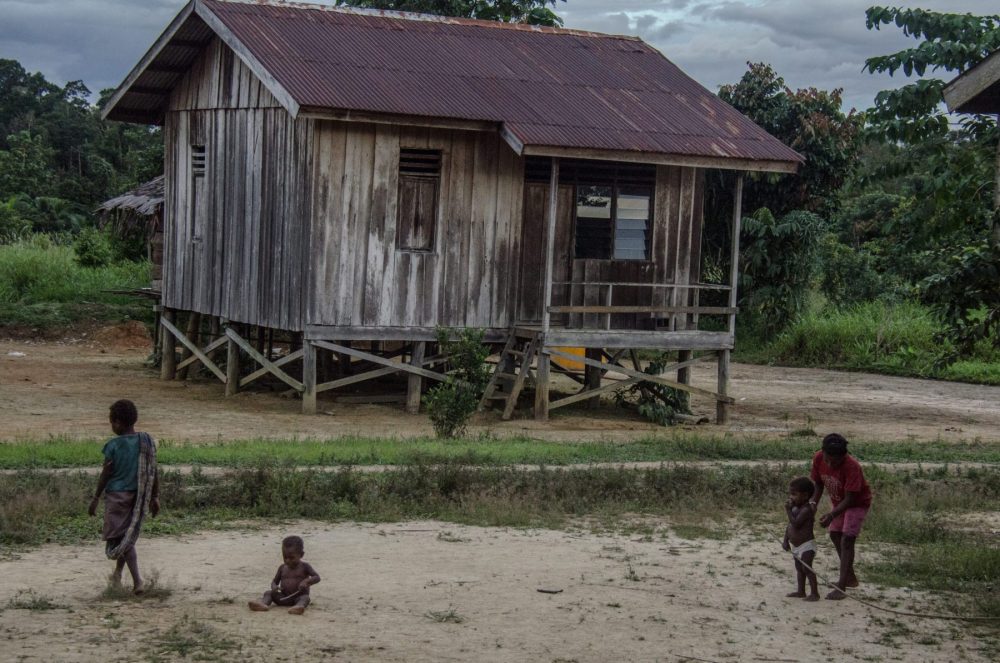
Mabul Village
We arrived to Mabul in the afternoon. Mabul is a government-built village of ramshackle wooden houses built to entice the Korowai out of the forest and into a settlement where they are more easily controlled. The houses, some food and supplies are all provided by the Indonesian government.
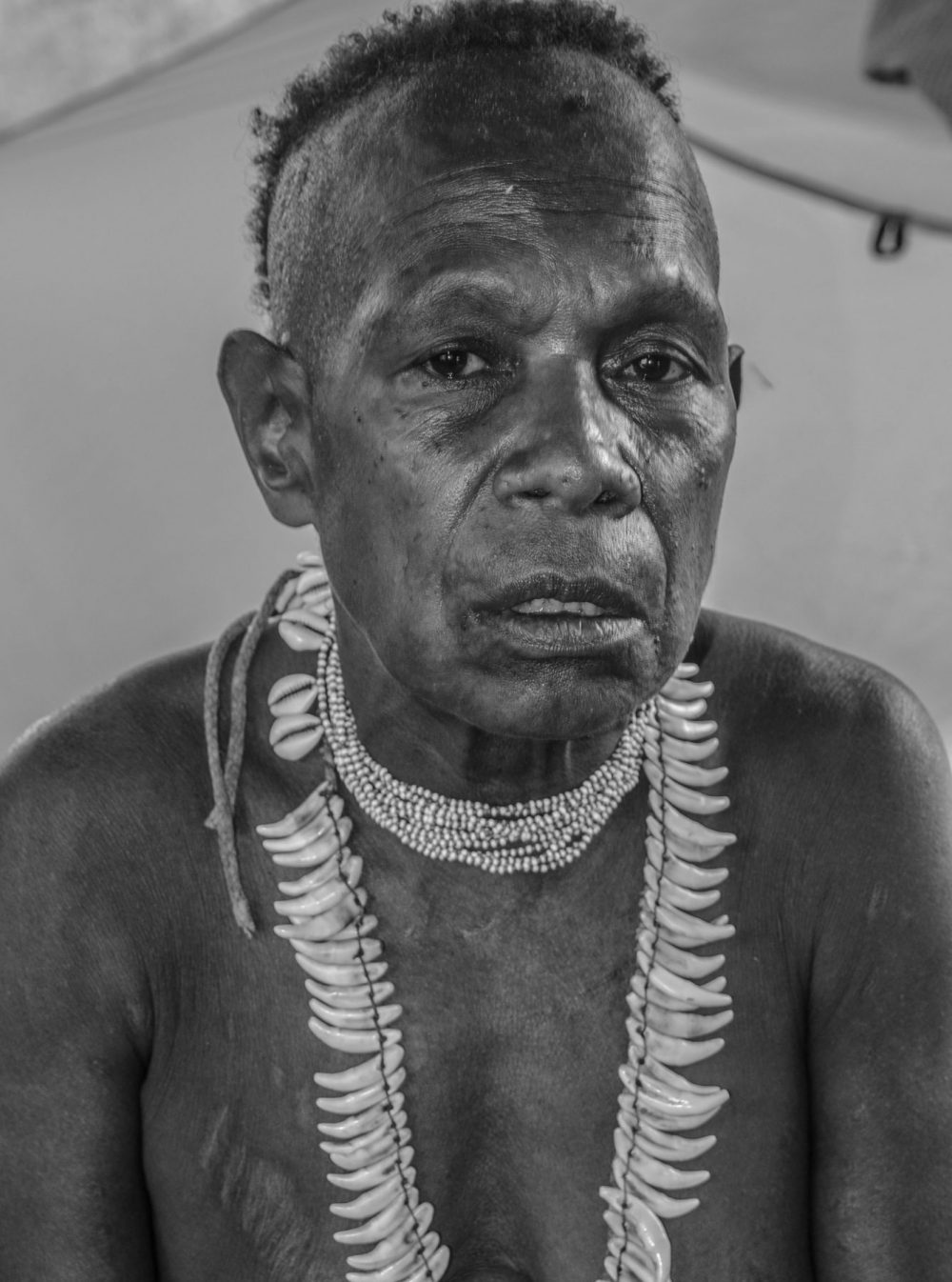
Korowai woman with crocodile teeth necklace

Kids playing with bows and arrows
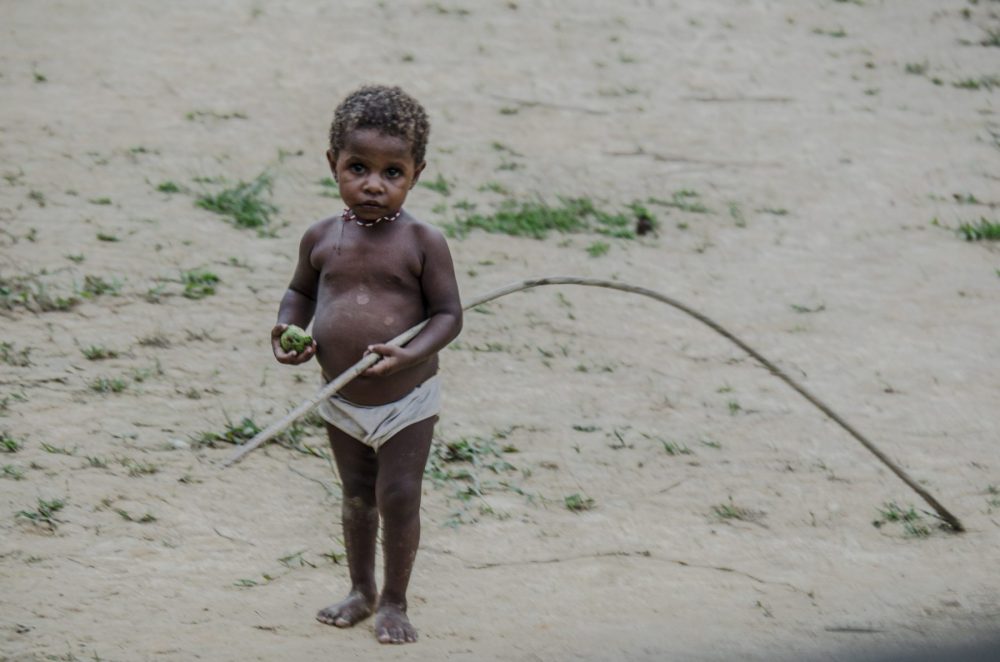
Korowai girl
A few hundred Korowai live in Mabul village. It was built in the late 70’s by the Indonesian government. Sadly, it is a place where Korowai culture on the most part has come to die. Korowai that move there become more dependent on the Indonesian government and lose their ability to live off of the forest. With this said, most Korowai that still live in forest camps, spend a large part of their year living in villages like Mabul too. Most Korowai in Mabul wore tattered western clothes. Some still maintained remnants of their culture such as necklaces, face tattoos, some women were topless in grass skirts and children played with bows and arrows. I spent the afternoon swimming cooling off in the village stream chasing the children and pretending to be a shark. I also wrestled the young Indonesian guys that operated our boat who kept referring to me as a kind of giant monster since I was so much bigger than they were.
There was one generator in Mabul for charging batteries. it was only used at night. Otherwise, the village was without electricity and conditions were very rudimentary. We slept on the floor of a hut that was elevated in stilts. All of us slept in the same room as our Korowai hosts. My sleep was interrupted not only from the snoring and incessant mosquitos but from the sudden onset of stomach illness accompanied by a fever and horrible diarrhea. I woke up in the middle of the night and couldn’t figure out how to get out of the house and I had no choice but to stumble over the sleeping bodies on the floor of the Korowai family I was staying with and relieve myself out the side of a window. Luckily a prescription pill for this kind of thing managed to help alleviate my symptoms rather quickly.
Trekking Into the Forest
In Mabul we organized porters to carry our food, packs, and other supplies. Our goal was to go into the forest for approximately a week. We paid 150,000 per porter/day. One porter was required for each person. Being that everyone in the village was unemployed, it was difficult to keep the number of porters to the actual number we needed. In total we ended up hiring about 6 porters. One porter I later observed wasn’t actually carrying anything.
Korowai inside the jungle live in small family groups usually in a small tree house. There are numerous trails into the forest that connect different treehouse family plots. Trails go for hundreds of miles into the jungle in all directions through the swamp forest and only the Korowai are familiar with them. I had one week in total to visit the Korowai which included the boat trip. I wasn’t sure how far we could go into the interior with this time, and I wanted to go as deep as possible, but I also heard that going deep into the forest didn’t necessarily mean that the Korowai living there would have no contact with the outside world since there are rivers in different directions that can provide access to the outside world from all directions. The goal was to enter the jungle and play it by ear. I would trek as far as I wanted to and see what families we would find along the way. I also knew that Korowai families in the forest did expect a small amount of money and some gifts like tobacco, medicine, or noodles from any foreigners that stay with them.
Before setting off, we stopped to visit the village elder of Mabul who is respected as a kind of chief for the area. We checked in with him to obtain his permission to enter the forest. He thanked us for having the courtesy to check with him and he warned us about the possibility of banditry in the forest. I did hear of an incident in the past where a group of travelers were robbed by bandits with bows and arrows. We were warned not to bring alcohol into the forest. I did have some for my birthday, but it was only a small amount and I planned to keep it hidden. The chief also warned Yaz to dress conservatively and not wear anything revealing in the forest. He warned that a girl had traveled to the village and was raped in the forest because she was wearing a bathing suit.
The chief shook our hands and we set off into the forest leaving the blazing open sun behind and descending into the dark, steamy world of the equatorial jungles. The hike was difficult as we walked through mud, across logs some very high..one slip would mean falling and breaking a leg or worse.
We trekked for 1/2 a day before we reached our first forest camp. A family with a few small children were living there and I was exhausted from having food sickness from the night before, so we decided to stay the night in the camp.

Trekking into the swamp forest
Our 1st Forest Camp
The Korowai family living in the camp stayed inside their treehouse. We stayed in a separate house that was located on the ground. All structures were made out of thatch and the forest around the houses was cleared and sago and other vegetables were planted for the family to eat. We spent the evening playing with the kids. I blew up some balloons and watched as the kids played with them and I took some polaroid photos to give to the family. The biting insects and heat and humidity were so bad that I spent most of my time cooling off in the clear pool in the stream next to the camp. I discovered that every Korowai camp is located next to a stream of running water in order for them to obtain drinking water.
Stayng with the first family with very comfortable and relaxing. They were very easygoing, and I realized this is partly because they have had foreigners stay with them before, and my guess was that this camp was the most visited out of all of them. One of the treehouses stood at least 100 feet tall. Treehouses this tall are not built any more by the Korowai. They traditionally were in the past but not anymore. These days treehouses are only built 20-40 feet above the ground. This one was built by the Korowai for a BBC series on tribal life. The Korowai men still retain the knowledge to build the towering treehouses because of cultural pride and because it is considered very manly to do so.
The Korowai man of the camp took us to the treehouse, and he climbed up to the top effortlessly. The ladder was made of vines and stretched and seemed to flimsy to carry my weight, so I abandoned the climb after about 20 feet. The ladder was built for a Korowai and not a foreigner like me. The Korowai were about half as big as I was.
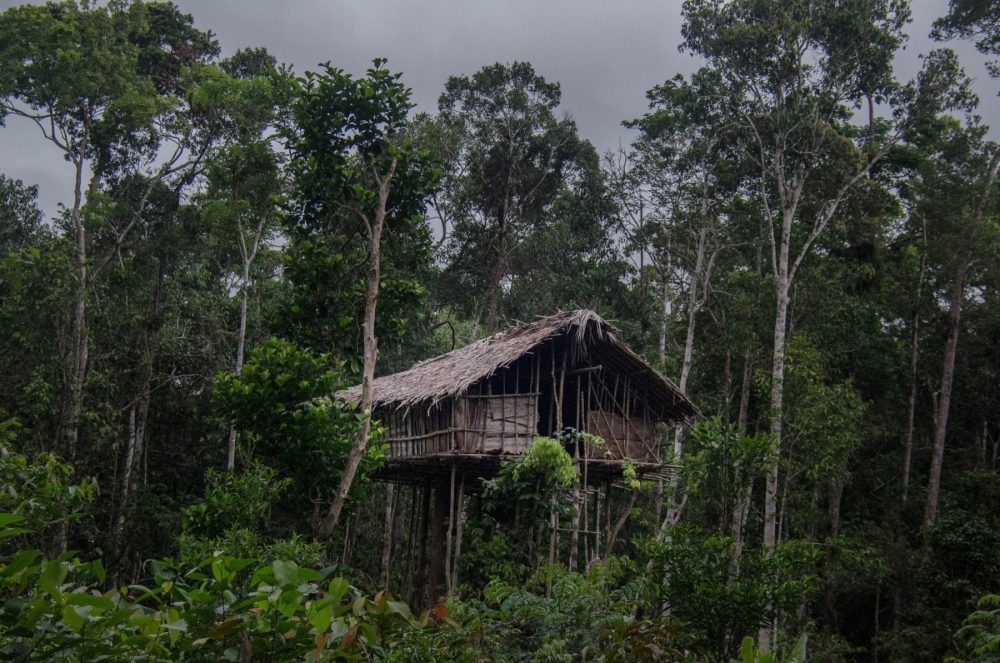
Treehouse that the family lived in
The first family we stayed with slept inside this treehouse. During the day they would work in the garden and relax around the thatched roof shelter that was ground level where we stayed. Then in the evenings they would climb up to the top of their treehouse and sleep there. The mother would climb the ladder with her child on her back. They stored some possessions, food and had a small pig inside their treehouse.
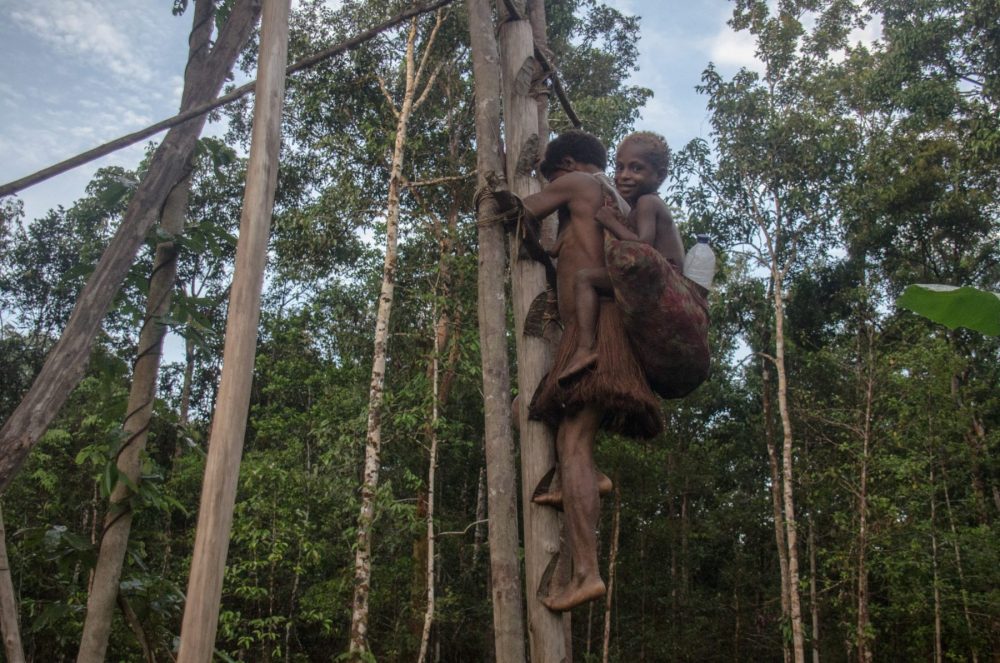
Korowai family climbing to treehouse
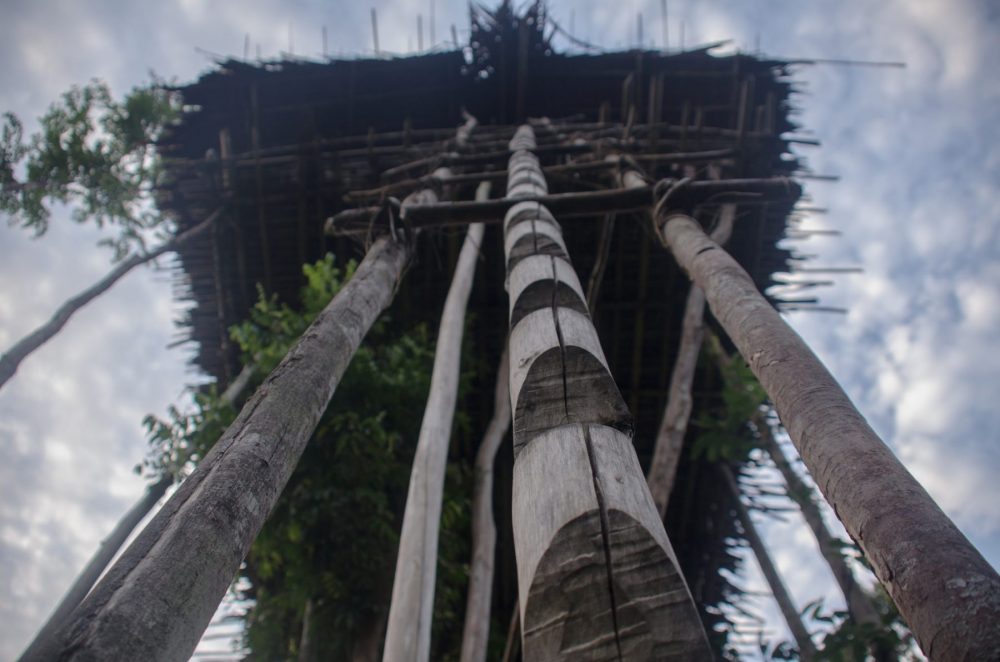
Small foot pegs on ladder for climbing to the treehouse. The pegs were too small for my huge feet.
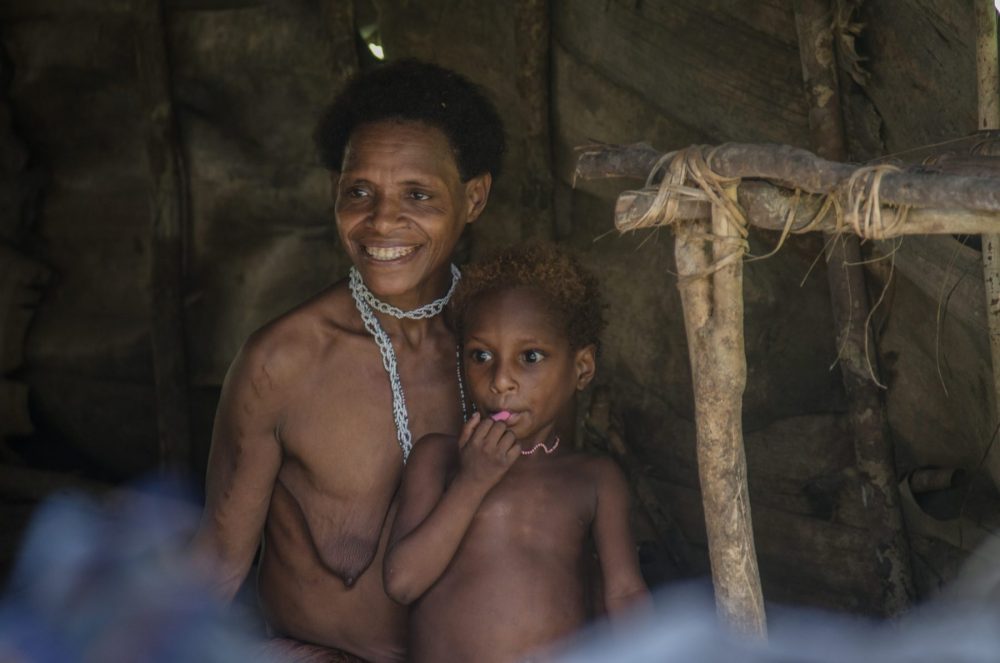
Korowai mom and child
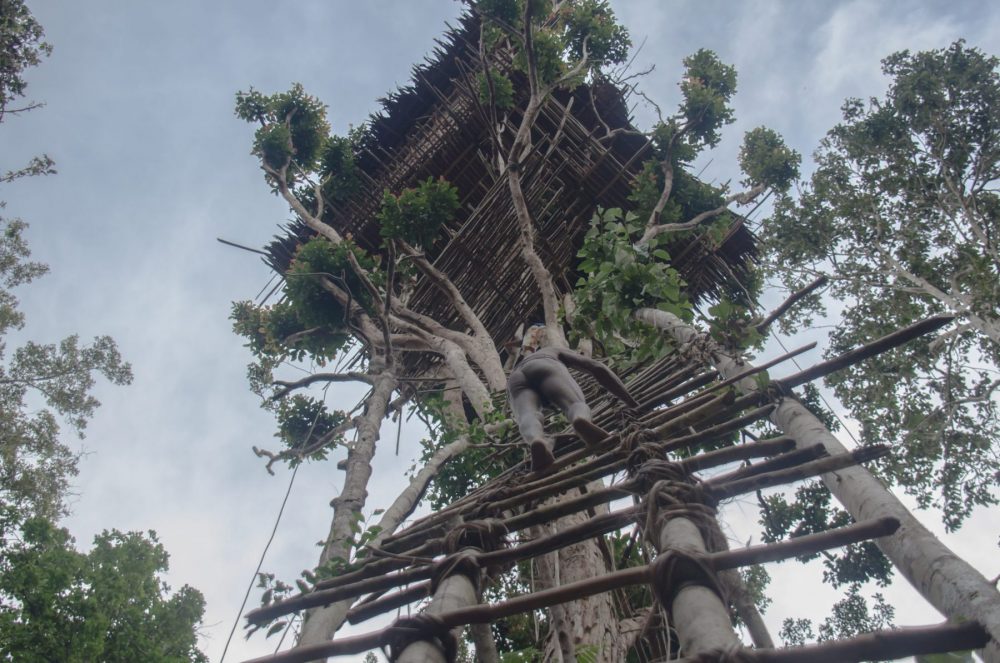
100-foot-tall treehouse built for BBC
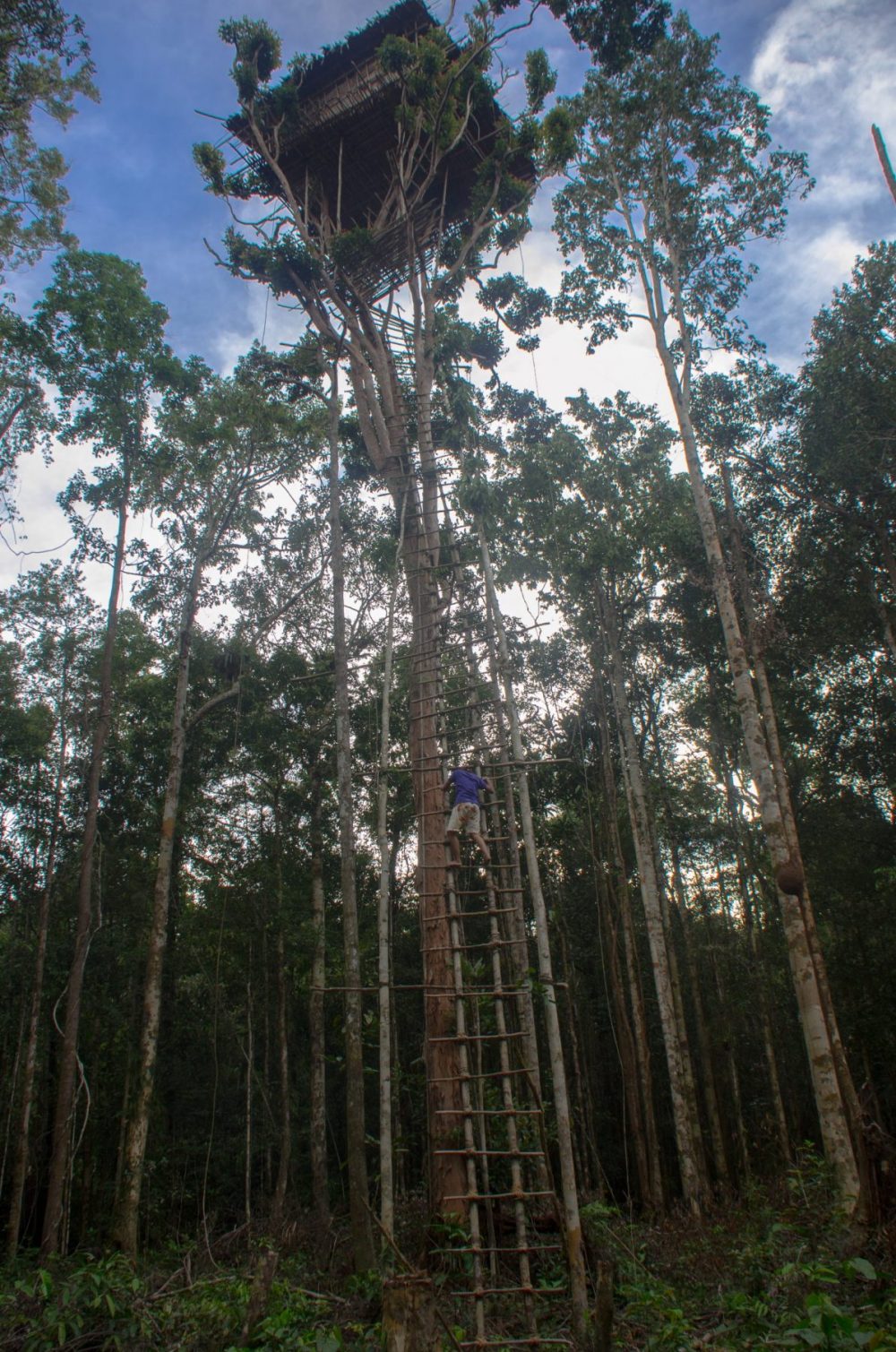
Yaz climbing the 100-foot-tall treehouse built for BBC. I tried but the ladder was way too flimsy for my weight and I turned back after climbing up about 30 feet.
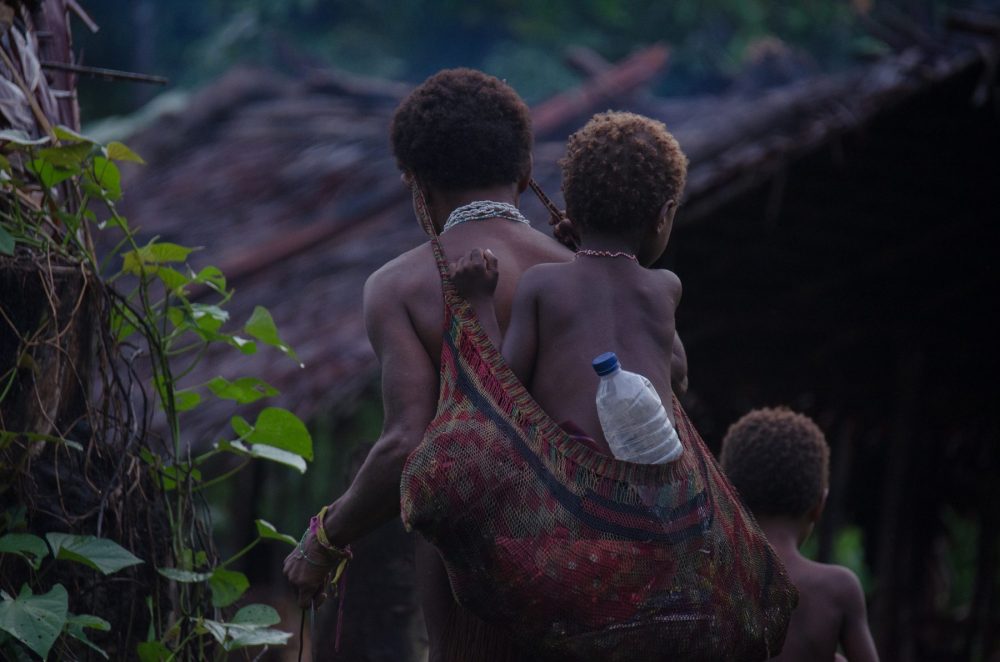
Korowai mom carrying child
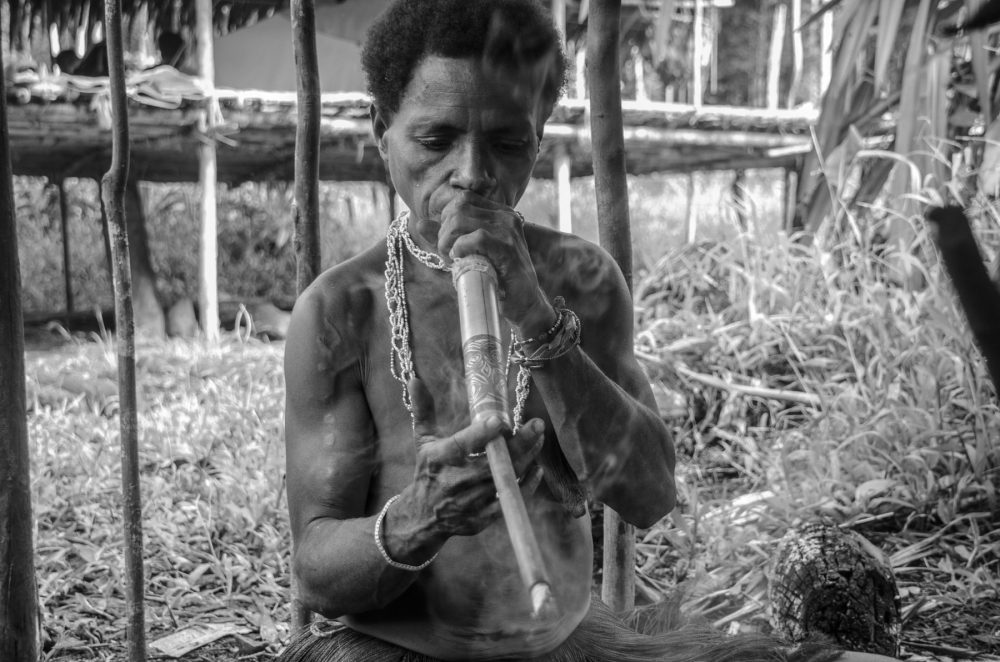
Korowai woman smoking tobacco pipe
Second Forest Camp
In the morning we relaxed in the stream cooling off and escaping the insects and we got off to a late start hiking to the next camp. We said goodbye to the Korowai family and set off into the jungle again. The jungle was more unforgiving today and the trail harder, mud deeper and bugs worse. We passed one empty field where a treehouse once was located but the family had since left. There was no one living there, and we didn’t see any Korowai on the hike. We never really followed a trail. The Korowai porters and guide seemed to know exactly where they were going. They walked barefoot and sang songs happily as we hiked into the jungle crossing logs, and streams and walking in mud at times. I wore my keens-waterproof hiking shoes with socks because I knew that my feet would be constantly wet from hiking in the swamp forest. We came across cassowary droppings. The cassowary aside from the snake is the most fearsome animal in Papua. It is a huge Dinasaur like bird, one of the largest in the word and it has a temper and can and has disemboweled people with its razor-sharp talons.
We arrived at the 2nd camp in the late afternoon. The camp consisted of a cluster of thatched huts and there were a few women who were in traditional grass skirts and topless. These women wanted nothing to do with us and seemed to make an effort to avoid us. A Korowai man, his wife and children eventually walked over to greet us. The man was friendly and when I reached out to shake his hand he didn’t know how to respond. I lifted his hand to show him how to shake hands and he did so with a confused limp without extending his fingers. It was clear to me that this place was very remote and that they do not often have foreign visitors. For this reason, I decided to make this our camp for the next two nights.
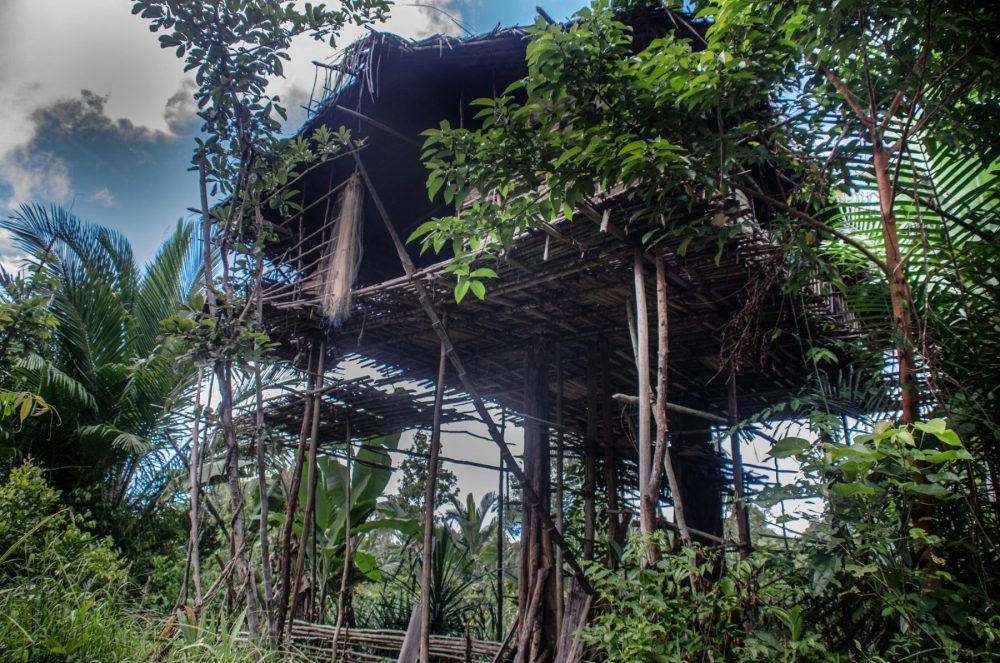
treehouse where the 2nd Korowai family stayed
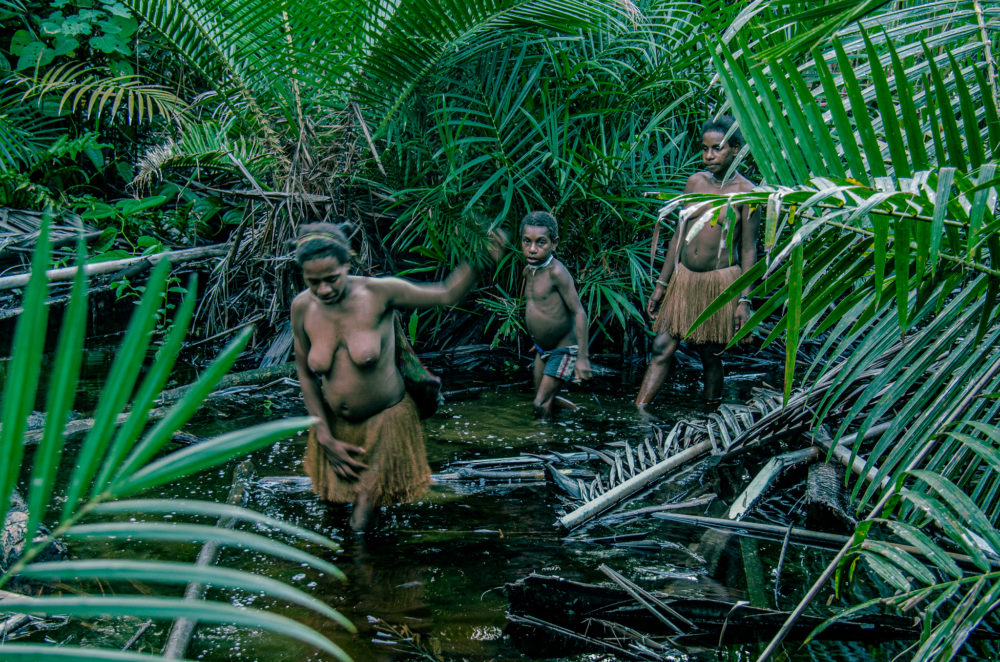
Korowai family coming to greet us from their treehouse
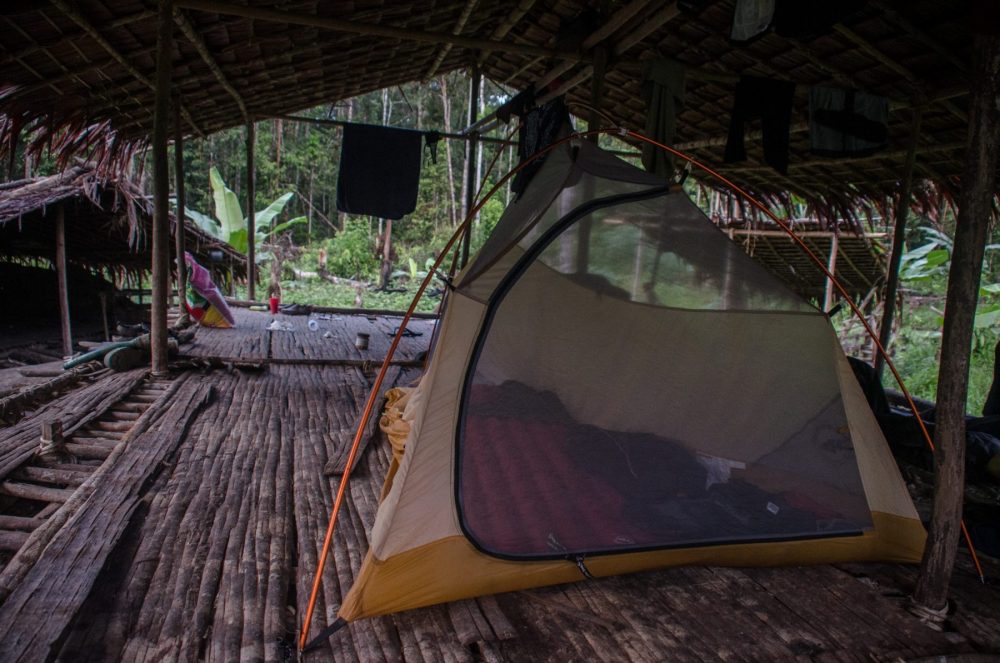
Where we slept inside our tents for protection from the biting insects. The porters slept in the open with only a palm front as a blanket at night. Do take the insects seriously. These are your biggest threat in Korowai country. By the end of the trip I was covered in painful bites and Yaz had a mysterious rash breakout on her back.

Me and Korowai Father
The Korowai dad was very friendly and was very interested in the photos I had to show him and his family of my home and life back in California. The Korowai spoke some Bahasa or if they didn’t a porter would translate in Bahasa and Yaz would translate to me in English. I donated Tobacoo to the man and took more polaroid photos to present as gifts to the family, which the family loved. I also blew up some balloons and gave them to the children. I could tell they had never seen balloons before, and they were enthralled with them until one of them popped and scared them.
I tried to become friends with the women Korowai in grass skirts that were staying in a hut beside ours, but they seemed very averse to my presence. These women I found out had relocated here recently because their treehouse deeper in the forest had burned down. It seemed that they had very little previous contact with foreigners especially men and they also may have had superstitions that made them weary of me.
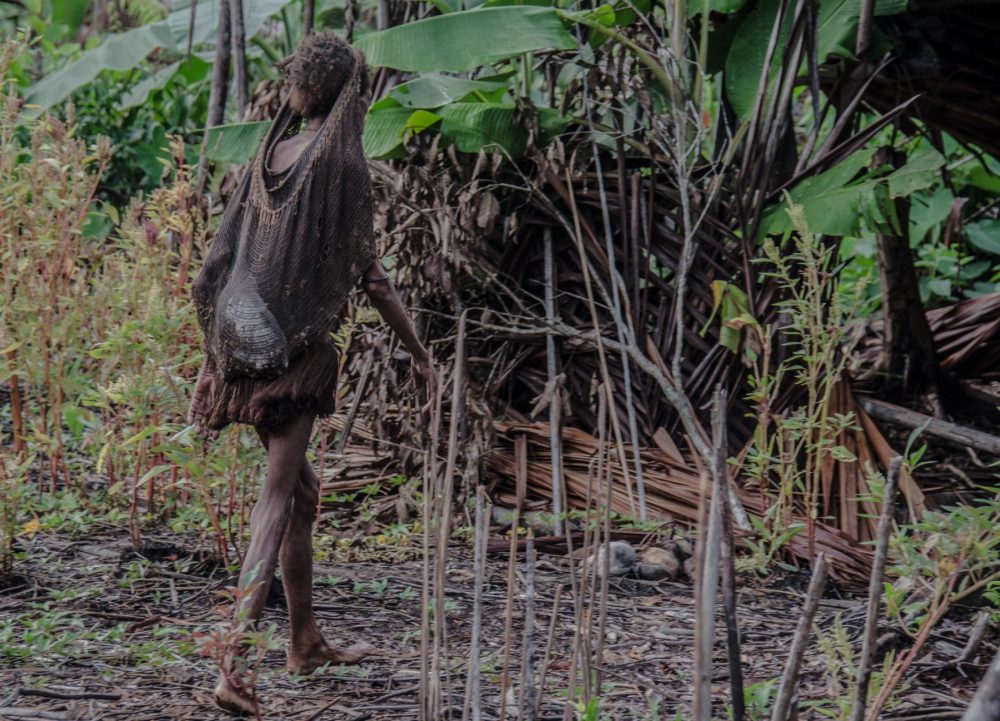
Korowai lady
I observed the women cooking rats and opossums over an open fire and I tried to take a photo of their small pig but one of them when observing me doing so quickly snatched up the pig and relocated the pig and herself away from my presence. I was able to get along well with the Korowai males and they were friendly and even playful, however some of the women were very shy and didn’t remain in my presence for long and if I were to come near them in some cases, they would slap my hand or react angrily to me. I never did understand what I did wrong. I tried as hard as possible to be respectful and to avoid taking unwanted photos. The Korowai women were more friendly with Yaz but they were still shy even with her.
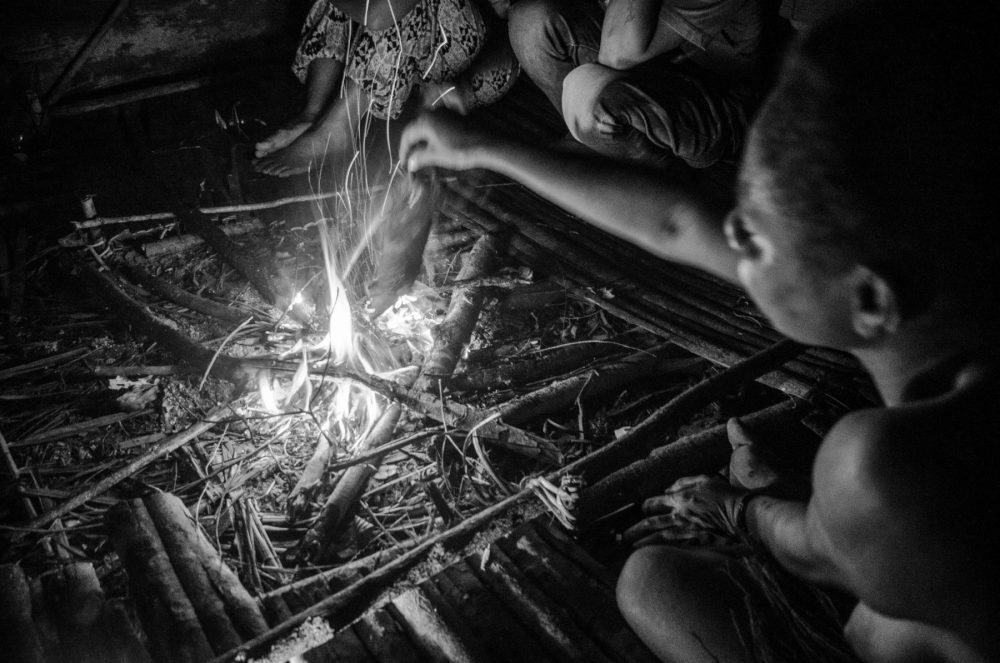
cooking opossums over the fire
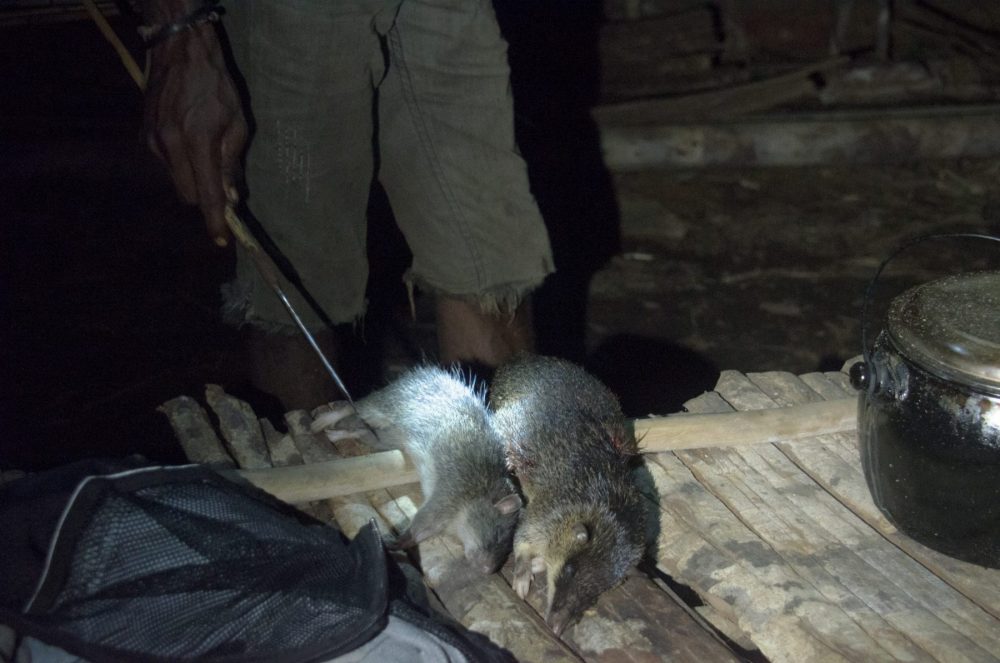
cooking opossums over the fire
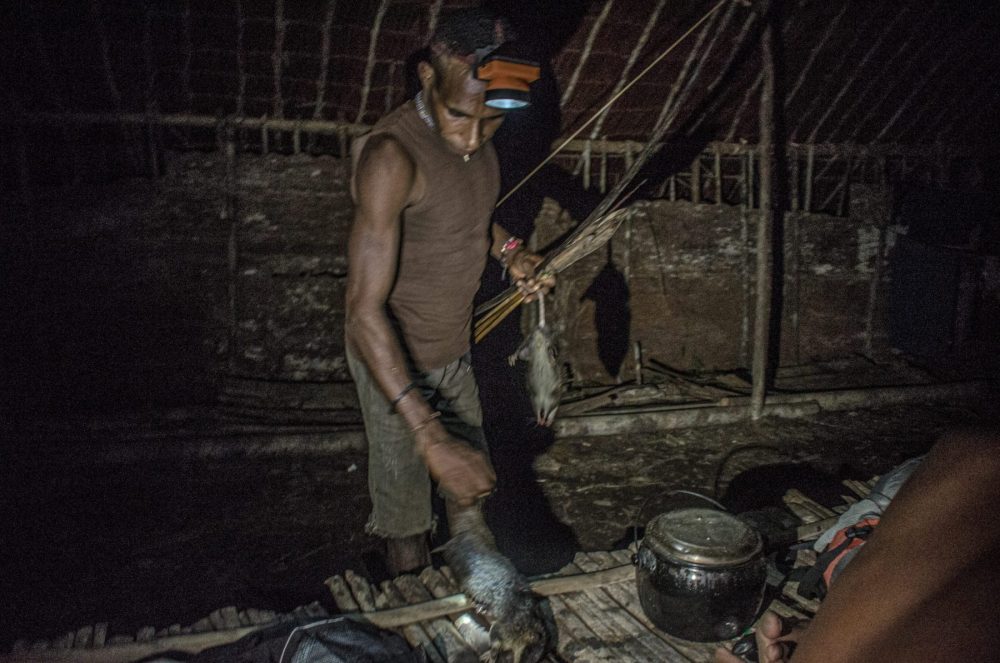
cooking opossums over the fire
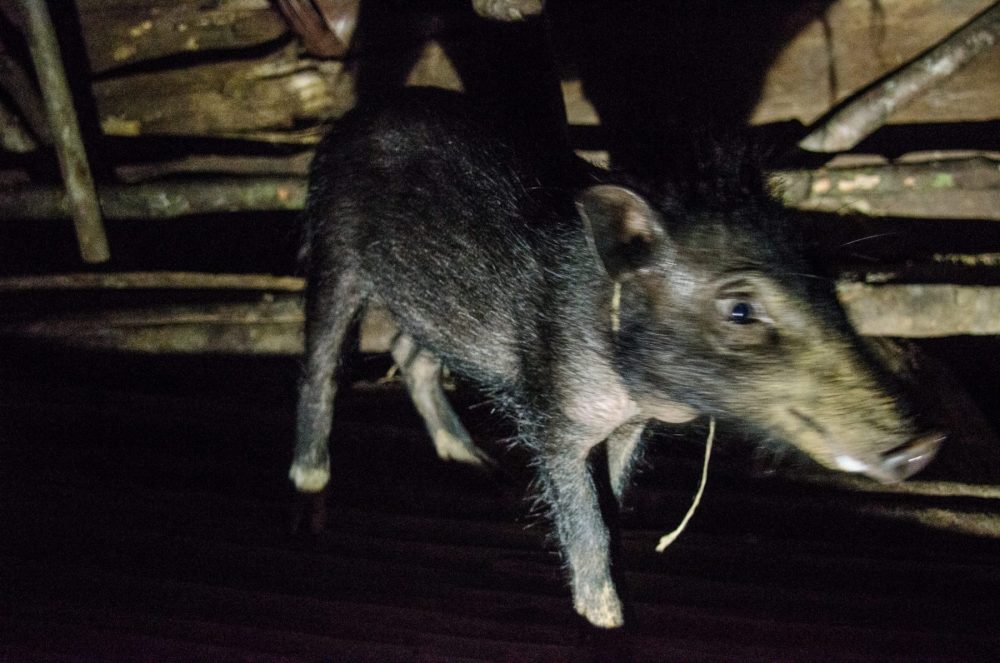
Miniature pig that the Korowai ladies owned
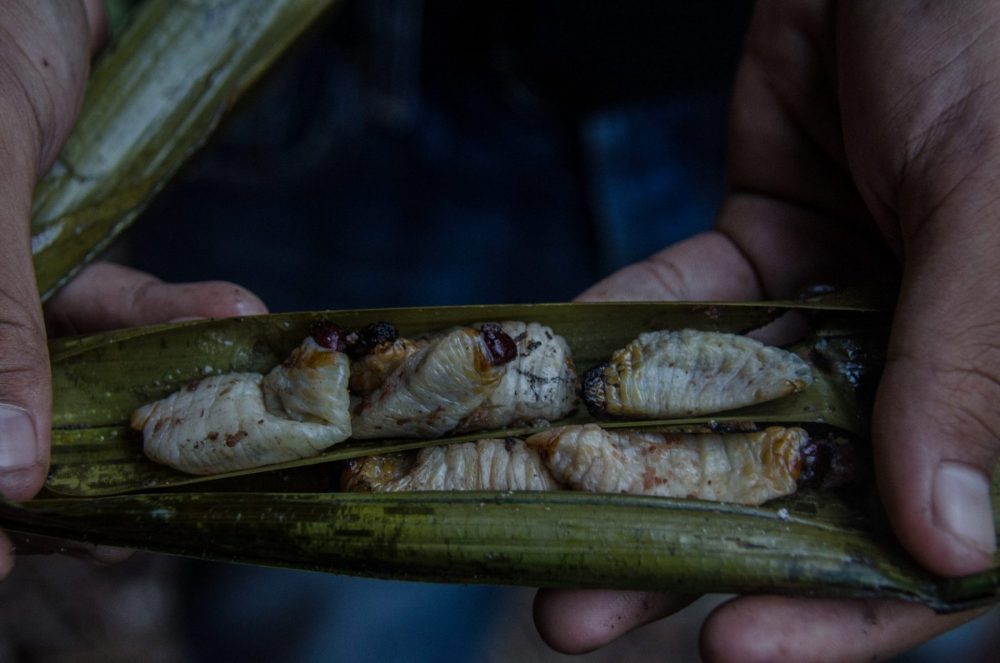
grubs
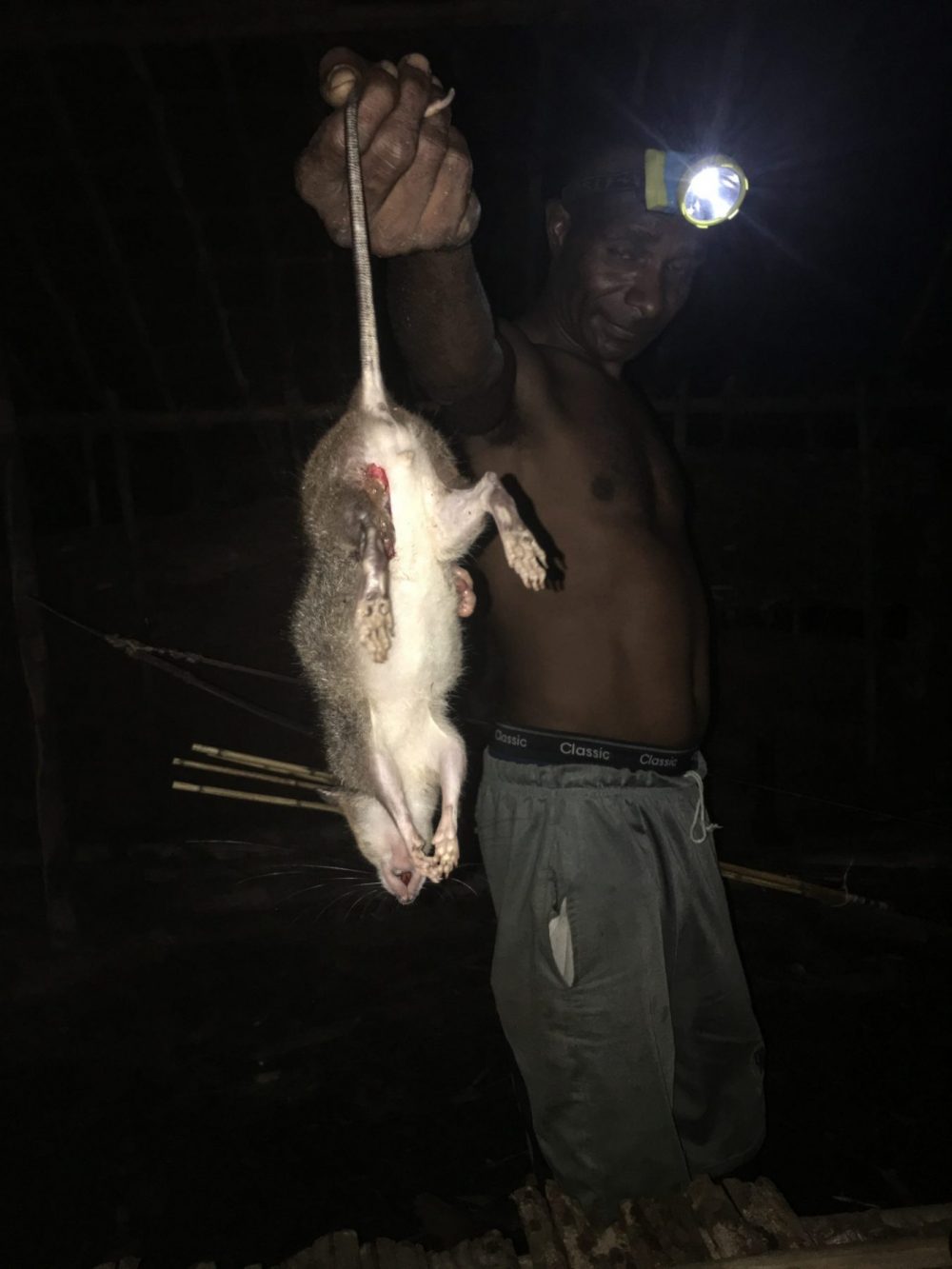
Rat caught in the forest
The Korowai porters asked me if I wanted to go hunting with them at night into the forest. Along with their hunting dog, they had bows and arrows and planned to go hunting rats, opossums and cassowary. I really regret not going with them. The next morning, they came back with more opossums and rats that they had caught. The dog had chased a cassowary and was injured by one as it got away. We ate some of the rat but after one bite I was suddenly feeling pretty full :). The porters also brought back some sago tree bark and they fished out some huge grubs that were inside. They cooked these and we also tried these. I’ll never forget biting a huge grub and having the juice inside explode into my mouth. I tried to be respectful and not spit it out, but my gag reflex took over.
The Korowai are good natured people and instead of being offended they just laughed. They passed the grubs around and ate them like skittles. But the grubs are a great source of protein in an environment where protein is hard to come by.
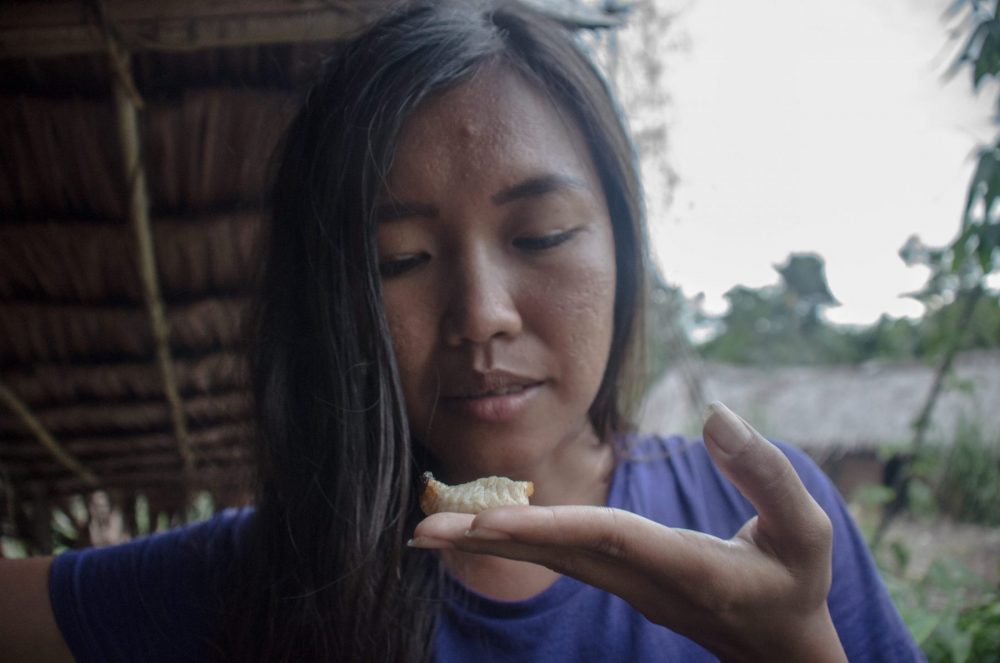
Yaz eating a grub
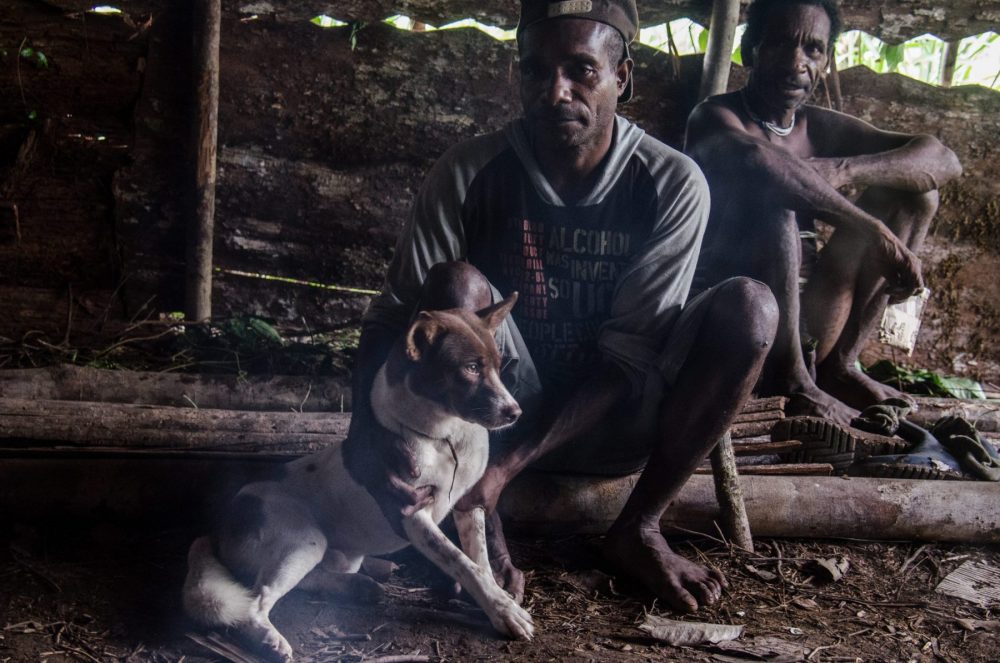
Hunting dog and Korowai porter who wore the shirt all week that stated “alchol was invented so ugly people can get laid.”
We spent most of the day submerged in the cool clear waters of the stream just near camp. The most difficult part was walking across the thorny vegetation to get to the stream and stepping into some pretty gooey undergrowth. The stream was the same place that we filtered water for drinking and cooking and where everyone bathed. It was a cool, and verdant paradise with thick vines, palms and ferns. I would find a log to sit on and just sit beneath the water out of reach of the stinging insects, mosquitos that might be carrying malaria and to relax, and listen to the sounds of birds and soak in the exotic surroundings. Of course, every paradise has trouble and there are venemous snakes and even the occasional crocodile in the river that you need to look out for.
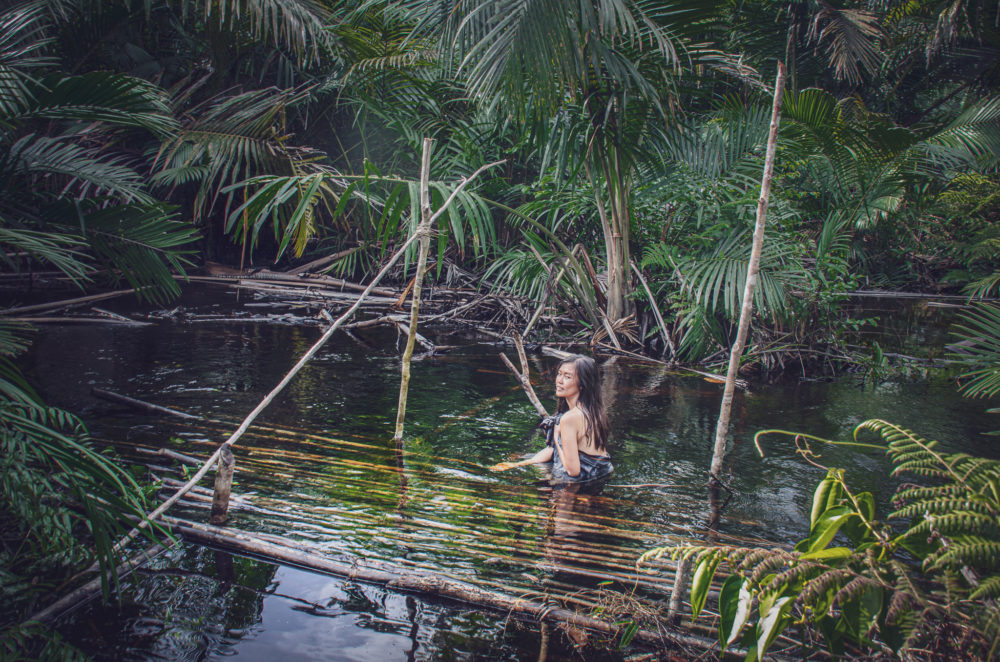
Yaz swimming
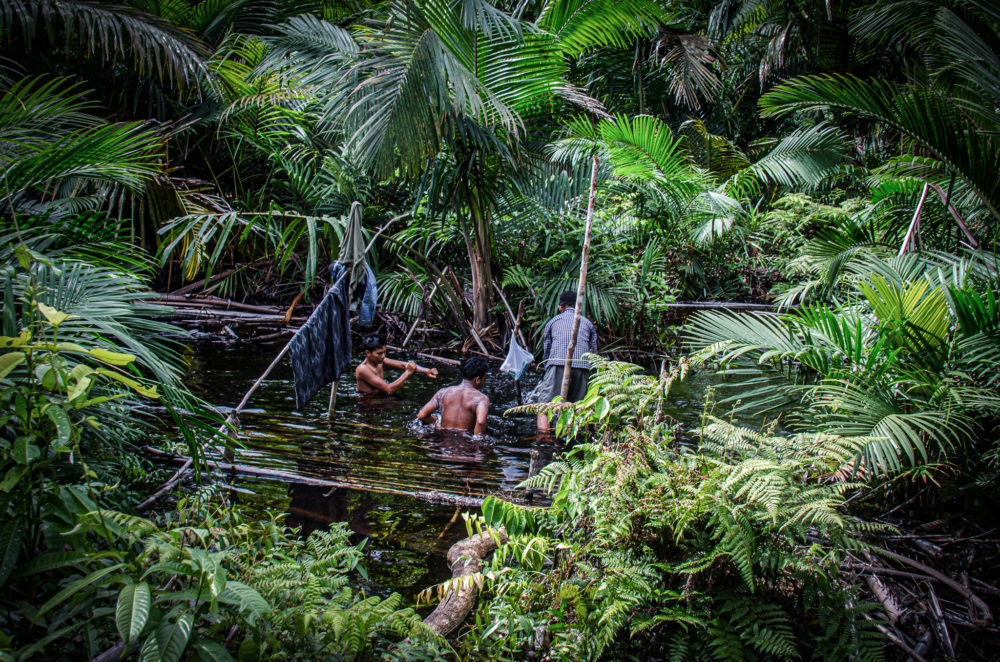
Boatmen bathing in the stream
I learned from the Korowai family that we stayed with that they had never seen a car but knew what one was. They never heard of Michael Jackson. They didn’t know where or what the USA is, and they do go back and forth to the village and have met foreigners before. I presented the father the rest of my peanut butter as a gift. he had never tried it before and so he took the jar and put his hand inside and scooped out half of it putting it all into his mouth and nearly suffocated to death.
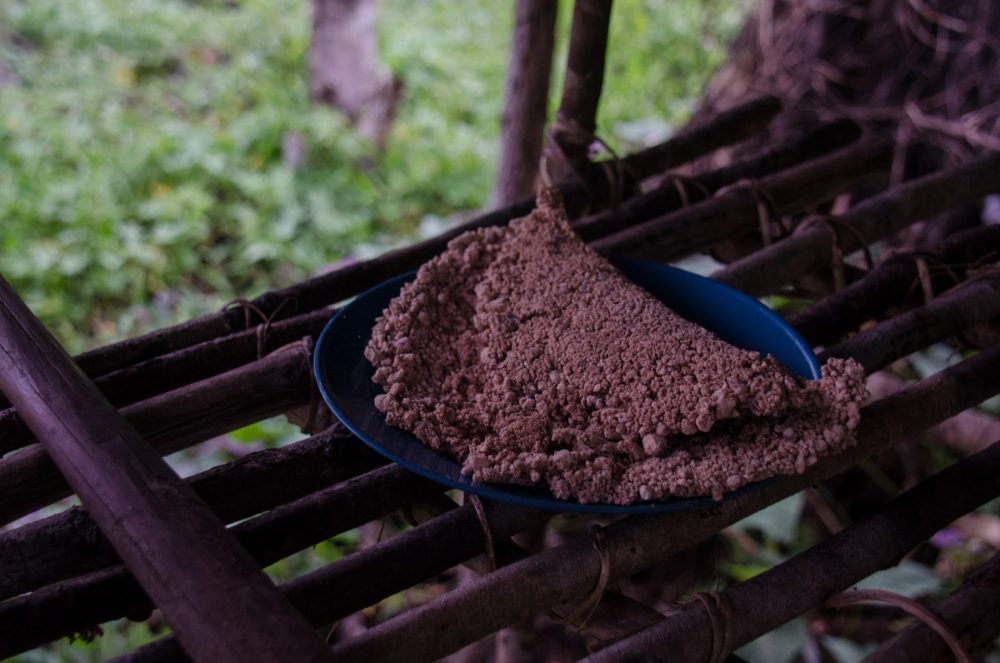
sago bread which is ground up from the tree after hours of hard work.
I gave him some of my water which he happily drank, and I showed him how to properly eat peanut butter by placing a little of it on the sago bread. One interesting encounter I had with the Korowai man of the camp was one morning when I decided to sleep outside of my tent because it was cooler. I stayed up a little late the night before with Yaz and the boatmen playing music, sharing a small bottle of whiskey and a small cake I brought for the occasion because it was my birthday. In the morning I woke up to see the Korowai man sitting across from me with his legs outstretched. He was fascinated by the size of my feet, and he placed his feet against mine and he found it funny that his feet were so small compared to mine. For a few moments he kept pushing his feet up against mine while he stared in absolute fascination at them.
I had many interesting conversations with the Korowai man. Yaz would translate for me because the Korowai man would speak to one of the Korowai porters who could speak Bahasa to Yaz. I learned that the Korowai have had contact with Christian missionaries, and they seem to practice some kind of a hybrid religion that still incorporates animistic ancestral worship and traditional superstitions. I asked if there is fighting between clans and the man said fighting has stopped but that there is a problem with people who become witches and since witches are no longer human it is ok to kill them. This statement was a little bit alarming and I’m sure that something likely was lost in the translation, but I did know before coming that people perceived as witches are believed to be a kind of demon possessed person that cast spells harming and even killing another Korowai. In a land where the life expectancy is already low, the people do not take chances by allowing witches to live among them and sometimes take matters into their own hands and have them killed.
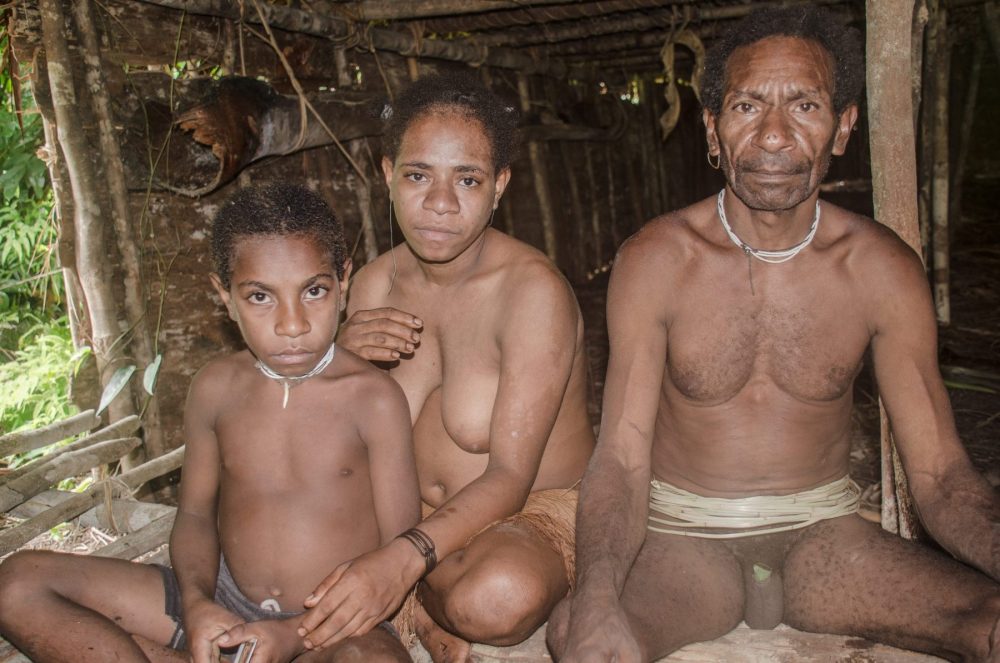
Korowai family we stayed with
The Korowai women would sometimes go topless but not all of the time. Also, some of the women wore grass skirts but not all of them. The boy wore ragged torn western clothes, but the man was completely naked with the exception of a leaf that is sort of shrink wrapped over his penis to give it the appearance of almost being tucked into his testicles. I made it clear to them that they didn’t have to wear any tradition clothes or lack thereof in my presence to impress me. I think that they do tend to be more likely to wear traditional dress while living inside the forest, but most do wear western clothing on occasion especially when going into the village of Mabul.
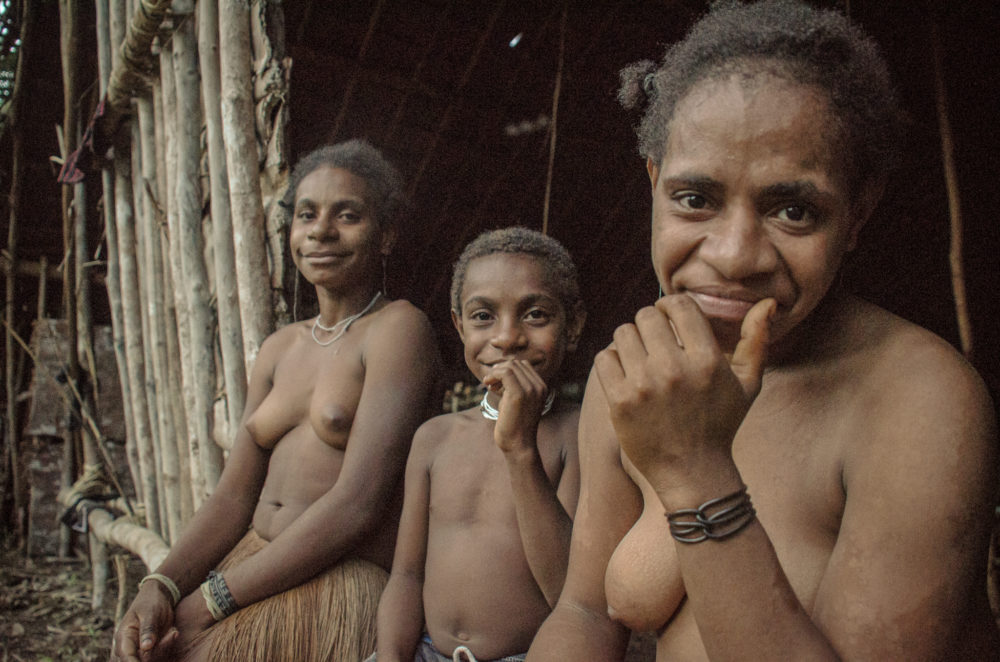
Korowai family
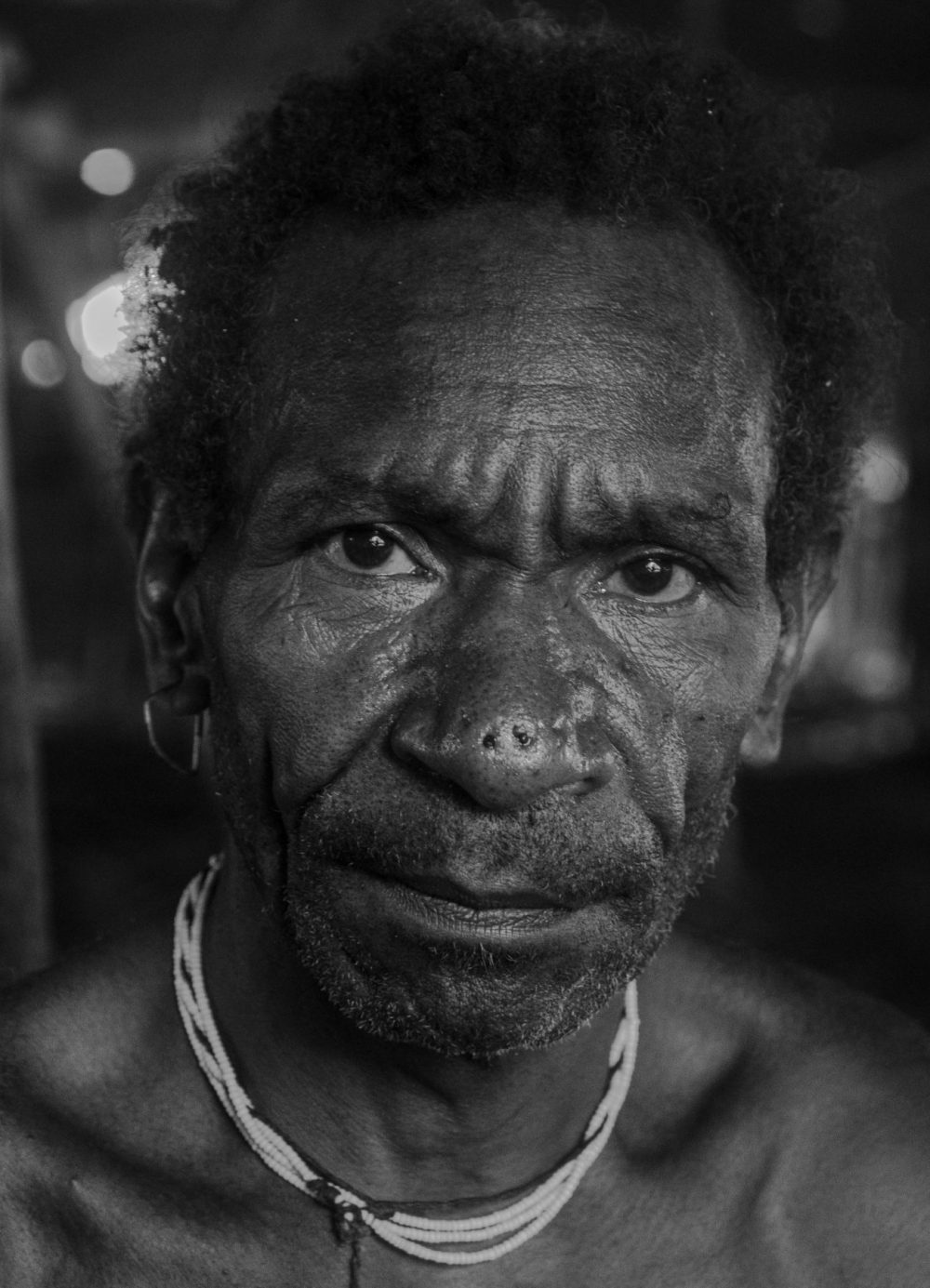
Korowai Father with nose piercings
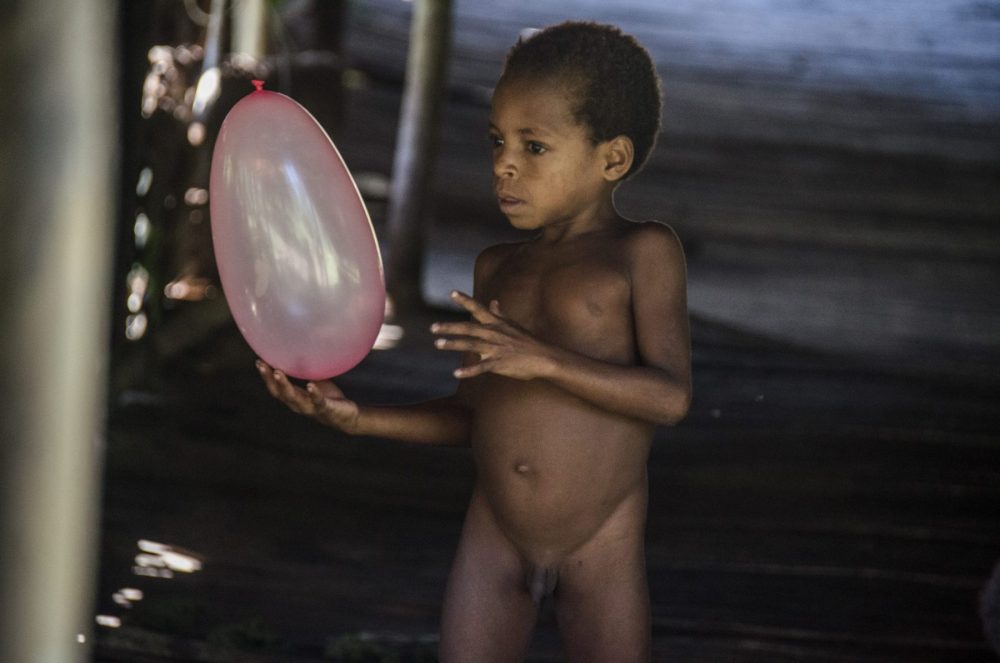
Korowai boy discovering balloons
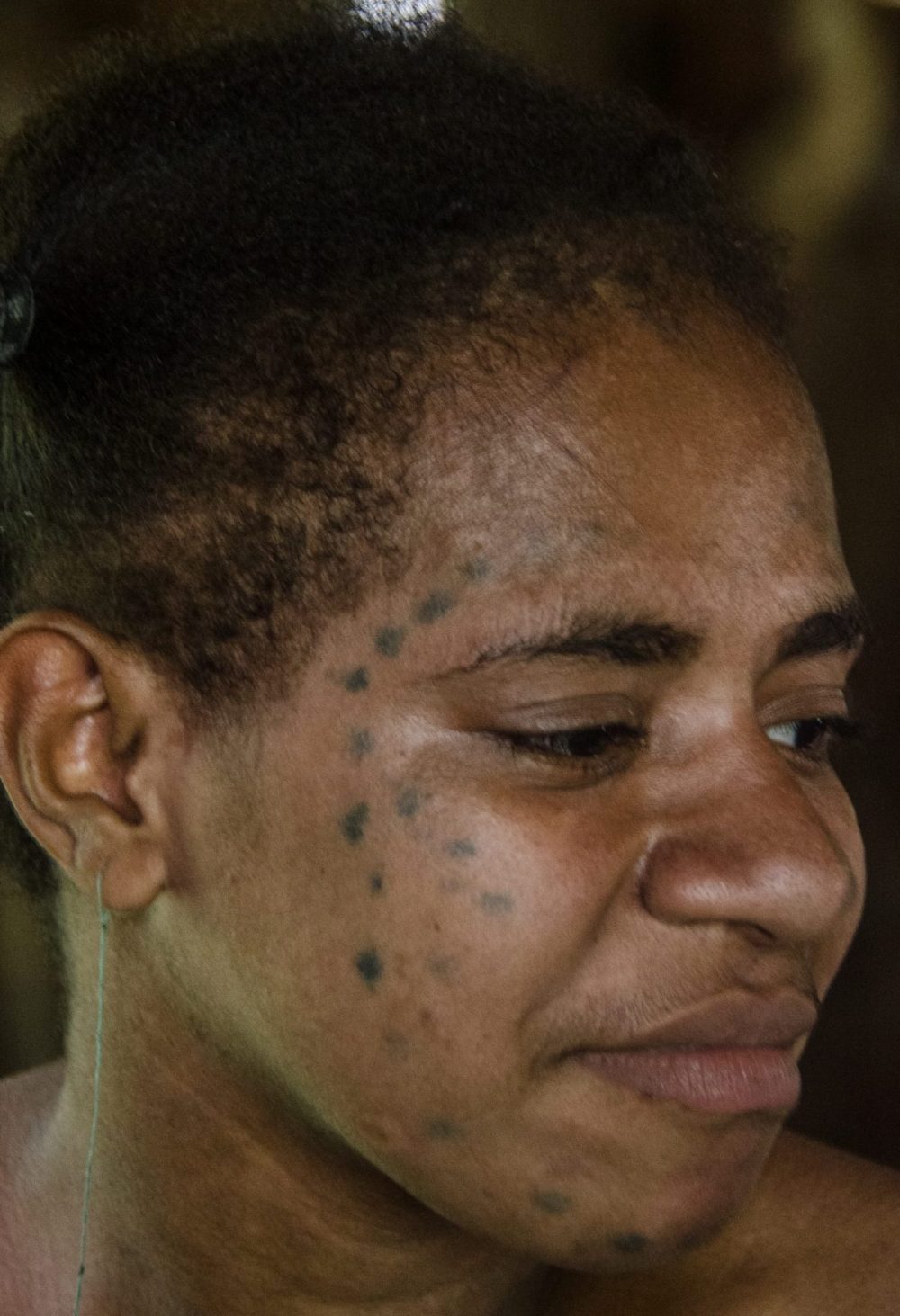
facial scarring
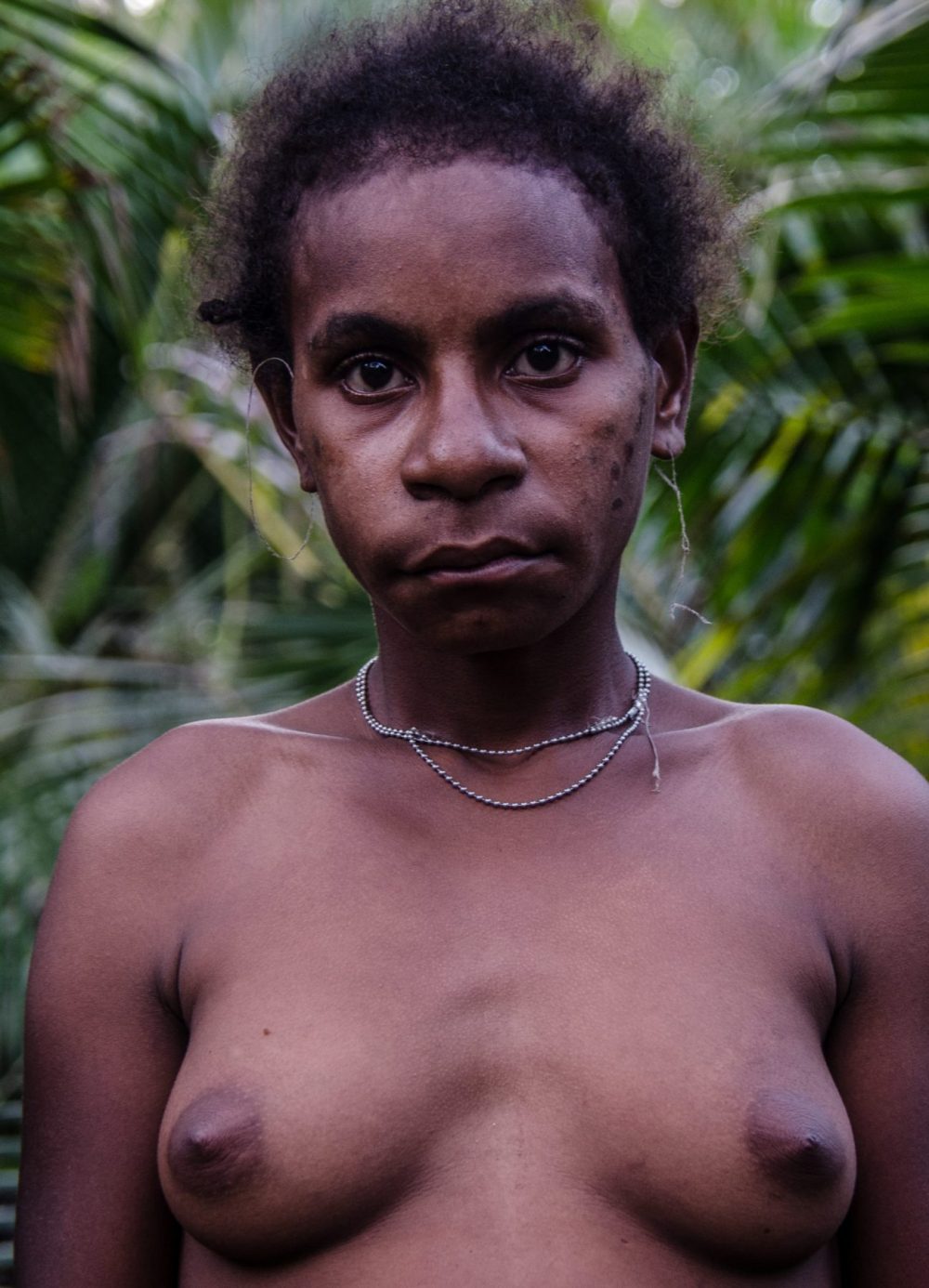
Korowai girl
On our last morning, I decided to head back and not risk running of money. The Korowai are no strangers to the value of money and each family we stayed with requested a per night fee that was approx. 30USD. I also left medicine, tobacco and food as gifts.
I would have loved to have gone deeper into Korowai territory but from what I hear from other expert travelers of the area, there are no uncontacted stone age era Korowai who have never seen foreigners. This is a thing of the past and no longer exists. However, I would have loved to go deeper and trek all the way into Kombai territory and into the highland eventually making it to Wamena. This is entirely possible with enough provisions and money. But I needed to get back on time to Dekai find a flight to Jayapura and cross the border to Vanimo in Papua New Guinea and spend a few days exploring there before my flight home. I felt content with meeting the families that I did, and we hiked back to Mabul village arriving in the afternoon passing through the camp we stayed at on the first night and saying hi to the family we stayed with on our first night. We set off in our boat stopping in a village in the dark, staying there on the floor and returning to Dekai the next morning and onward to Jayapura by Trigana Airlines. From Jayapura I crossed the border into Papua New Guinea into the remote town of Vanimo.

